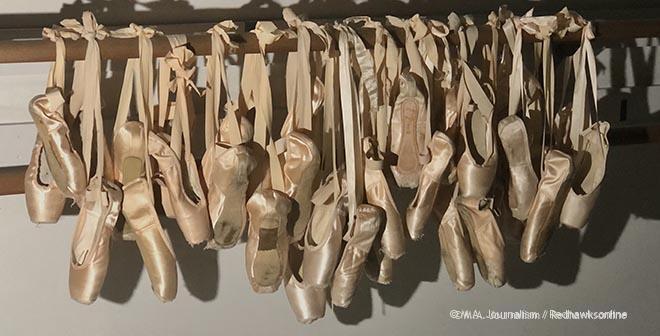Dancers are sacrificing their mental and physical health in an attempt to meet outdated body image standards
Little girls watch The Nutcracker, wide-eyed with awe, as ballerinas twirl around in pretty pink costumes. Snow falls, backdrops change, and the stage seems to be a magical place. From an outsider’s view, ballet is often associated with joy, grace, and the holidays. But what is lurking behind the curtain? With unrealistic body image standards, toxic diet culture, and an ever-present sense of competition, is ballet as innocent as it seems?
“When I was around eight, one of my teachers told me I shouldn’t be eating McDonalds,” said Emily Brewer, a freshman in high school and pre-professional student at a ballet school in Dallas, Texas. “I have had countless teachers tell me to suck in my stomach. I started thinking that I needed to conform to stereotypes surrounding ballet dancers and what they eat and what they look like,” Brewer said. “It became normal for teachers to comment on my body [in a negative way] and I barely noticed how wrong it was anymore. This really impacted my mental health and led to disordered eating.”
Brewer is not alone. High-school senior Aubrie Owen had shockingly similar experiences and observations.
“There is this stereotype that ballet dancers need to be thin,” said Owen, who has been dancing classically for almost 13 years. “I also think that young kids are really impressionable and when teachers perpetuate these stereotypes….younger kids will want to do whatever the teacher says. [Dancers] often really hyper-focus on that one thing they don’t like and they can’t see the big picture.”
As Owen has recognized, both ballet teachers and the perfectionism involved in a demanding sport like ballet can lead to disordered eating. However, there are thousands of factors that can contribute to the silent epidemic of eating disorders in ballet.
“I think there are some underlying issues when it comes to things like eating disorders and I think that there are some individuals that are more predisposed so they are more at risk to begin with,” says school counselor Christine Paton.
Examples of people who might be more at risk for eating disorders include individuals with anxiety and obsessive compulsive disorder, and perfectionists. According to the National Eating Disorders Association, two-thirds of people with anorexia also showed signs of an anxiety disorder.
“There is a certain body type, particularly with ballet. You have to fit a role. I think the messaging from coaches and dance teachers can have a real impact, so if you’re someone who already has a predisposition…those two things come together and I think that is why we see higher rates of eating disorders in dance,” Paton said.
It is obvious that there is an issue within the dance industry surrounding body dysmorphia and disordered eating. In fact, studies show that up to half of professional ballet dancers suffer from disordered eating. As the number of spots available in ballet companies shrink, professionals struggle to fit the outdated mold of the “ballet body.” Trying to lose one pound can turn into five, and then ten, creating an unhealthy and addictive downward spiral.
Is there hope for the next generation of ballerinas to grow up in a healthy dance environment?
Sports nutritionist Kaela Colvard of the Training HAUS in Eagan has spent time working both with individuals who have eating disorders and with ballet dancers. She was able to provide insight geared towards dancers and ballet programs on how to promote a healthy relationship with food.
“It truly stems from the top down,” Colvard said. A healthy relationship with food “comes from those coaches creating…that ideal environment, where a team could openly discuss food eating habits in a positive way, but also support it. Whether it’s competitive…multiple performances a day, making sure that those coaches are advocating for positive nourishment and nutrition,” Colvard said.
Unfortunately, like many mental health issues, eating disorders have become a taboo subject. Dancers of all ages struggle in silence. As Colvard noted, It is extremely important to be aware of the steps we can take as a community to further our knowledge and understanding of eating disorders.
“I think it’s really important to talk about [an eating disorder] but not to glorify it,” says Owen. “I think that teachers and older dancers need to just set a good example by watching what they say and by trying to be healthy in a way that is sustainable.” “The reality is we need people who are brave enough to not fit the mold and create change,” Owen continues.
The key to change is raising awareness and taking steps to start the hard conversations. As Ruth Bader Ginsburg has advocated, “fight for the things you care about but do it in a way that will lead others to join you.”
“Every single person in the world has something about themselves they don’t love, and that they wish was different, or wish was like someone else,” said Owen. “Stop staring at the one thing you hate about yourself in the mirror, look at your entire line,” says Owen. “If you focus on all the negativity then nothing productive is going to happen.”

